Less than a month ago, Elon Musk shared his audacious plan to launch a million people to Mars and beyond, all in hopes of backing up humanity for when some future apocalyptic calamity dooms Earth.
Musk's 63-minute presentation showed off intricate computer renderings of rockets and spaceships, all parts of his so-called Interplanetary Transport System (ITS).
Because he skipped over a lot of technical details, however, Musk logged onto Reddit on Sunday afternoon to let his most discerning fans squeeze information from him in an Ask Me Anything session.
During that Q&A, we learned about a very important test SpaceX allegedly has planned "in the coming weeks", says Musk: filling up an enormous carbon-fibre fuel tank, shown below, that will be essential to making the ITS spaceship work.
The tank - which happens to be the spaceship's core structure around which everything else is built - has to withstand incredible pressures and stresses at blisteringly cold temperatures, otherwise it might leak or even explode.
Musk shared images of the massive structure toward the end of his September 27 talk at the International Astronomical Congress (IAC).
When Reddit user nalyd8991 asked Musk for more information about it on Sunday, he said the gargantuan carbon-fibre tank "was really the big news" of his IAC talk - or at least "for those that know their stuff".
'The hardest part of the spaceship'
"[T]his is really the hardest part of the spaceship," Musk said at the IAC. "The other pieces … we have a pretty good handle on, but this was the trickiest one. So we wanted to tackle it first."
In short, the entire spaceship will be centred around such a tank - so getting it right is crucial. Here's where it will be placed in the spaceship:
Carbon-fibre fuel tanks for spacecraft aren't a new concept, since Boeing and NASA began work on a huge ones 2014, but we've never seen one this enormous at roughly 40 feet (12.2 metres) wide.
Here's what it looks like from the inside:
Engineers likely made the tank out of carbon fibre because that material is lighter, shrinks less, and is stronger than the metal alloys that many cryogenic fuel tanks are made out of.
So it will presumably make for safer transport to Mars while using less fuel (though at a considerably higher cost of construction).
The material isn't easy to work with, though, as Musk explained during his IAC talk:
"Even though carbon fibre has incredible strength-to-weight, when you want one of them put super-cold liquid oxygen and liquid methane - particularly liquid oxygen - in the tank, it's subject to cracking and leaking and it's a very difficult thing to make.
Just the sheer scale of it is also challenging, because you've gotta lay out the carbon fibre in exactly the right way on a huge mould, and you've gotta cure that mould at temperature, and then it's… just really hard to make large carbon-fibre structures that can do all of those things and carry incredible loads."
During his Reddit AMA on Sunday, Musk dropped a few bits of new information about the tank as well:
- "[T]he flight tank will actually be slightly longer than the development tank shown, but the same diameter," Musk said.
- He also noted it was "built with latest and greatest carbon fibre prepreg", or carbon-fibre that's pre-impregnated with glue-like resin to make it tougher. "In theory, it should hold cryogenic propellant without leaking and without a sealing linker," he said. "Early tests are promising."
- Finally, he teased a much grander test: "Will take it up to 2/3 of burst pressure on an ocean barge in the coming weeks."
Although Musk didn't answer any follow-up questions about this mysterious ocean test, we assume that by 'barge', he means one of the robotic drone ships that have caught a handful of SpaceX's self-landing Falcon 9 rocket boosters in the recent past, such as the one shown below.
We also don't yet know how SpaceX plans to pressurise the giant black tank. It could be with plain old air, but it might be their fuel of choice for Mars: flammable (and explosive) methane gas.
Several things might suggest this: First, lugging a giant orb out into the middle of the ocean sounds like no simple effort, so there's an expectation that the device could explode - not just merely leak.
If no one is around and it blows up, its shrapnel (and possibly flames) can't hurt anyone. Luckily, SpaceX's ocean barges have proven capable of withstanding extreme blasts in the past:
Second, Musk said SpaceX performed "initial tests with the cryogenic propellant" that "actually look quite positive. We have not seen any leaks or major issues," he said.
If the company has already pumped methane into the sphere-like tank before, it stands to reason they will try again to get even more data on its performance.
SpaceX representatives declined to provide Business Insider with more details on the test, including what would be pressurising the orb.
This article was originally published by Business Insider.
More from Business Insider:




